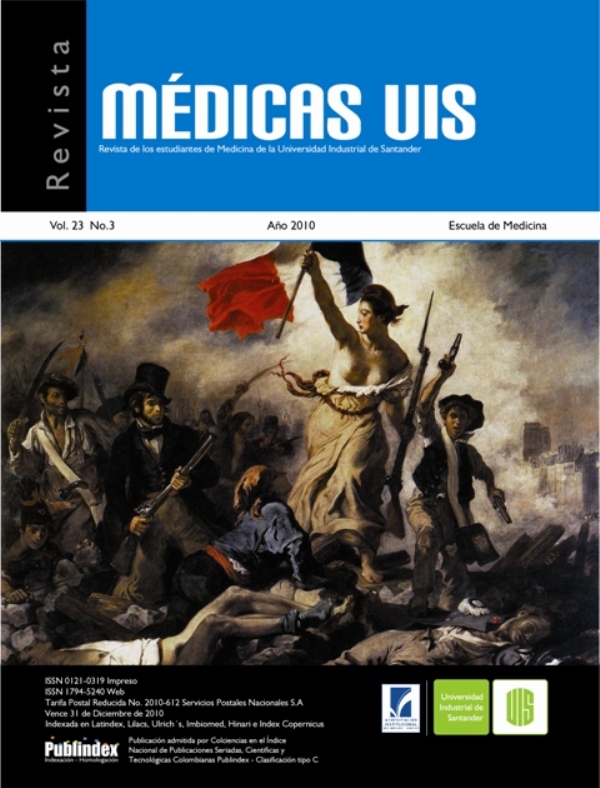Resumen
Los bezoares del tracto digestivo constituyen una patología infrecuente, son colecciones de material ingerido que se acumula en estómago e intestino. El tricobezoar hace referencia a un cúmulo de pelo, su sospecha clínica se establece en pacientes jóvenes predominantemente mujeres con historia de masa epigástrica, pérdida de peso y síntomas obstructivos. El diagnóstico se puede realizar con imágenes y endoscopia y su tratamiento consiste en su remoción. Se presenta un caso de tricobezoar perforado en paciente femenina joven, el cual es manejado en el servicio de Cirugía General del Hospital Universitario de Santander.
Palabras clave: Tricobezoar. Bezoares. Tricofagia.
Referencias
1. Byrne WJ. Cuerpos extraños, bezoares e ingestión de cáustico. Clin Endosc N Am. 1994;1:103-24.
2. López-Cantarero Ballestero M, Belda Poujulet R, Narbona Calvo V, García Jil JM, Gómez Valverde R. Fitobezoar: a propósito de 5 casos. Revisión etiopatogénica y tratamiento. Rev Esp Ap Digest. 1986;69(1):31-6.
3. Kim SK, Beck AR. Multiple Small Bowel Perforations: an Unusual complication of trichibezoar. Mt Sinai J Med. 1972;39:293-9.
4. Cremer SA, Gelfand DW. Esophageal bezoar resulting from enteral feedings. J Parenter Enteral Nutr. 1996;20(5):371-3.
5. Taylor JR, Streetman DS, Castle SS. Medication bezoars: a literature review and report of a case. Ann Pharmacother. 1998;32(9):940-6.
6. Deslypere JP, Praet M, Verdonk G. An unusual Case of the Trichobezoar: The Rapunzel Syndrome. Am J Gastroenterol. 1982;77(7):467-70.
7. Goldstein S, Lewis J, Rothstein R. Intestinal obstruction due to bezoars. Am J Gastroenterol. 1984;79(4):313-8.
8. Lamerton AJ. Trichobezoar: two cases report-a new physical sign. Am J Gastroenterol. 1984;79(5):354-6.
9. Lee J. Bezoars and foreign bodies of the stomach. Gastrointest Endosc Clin N Am. 1996;6(3):605-19.
10. Rider J, Forestl F, Garrido J. Gastric Bezoars: treatment and prevention. Am J Gastroenterol. 1984;79(5):357-9.
11. Andrus C, Ponsky J. Bezoars: Classification, pathophysiology and treatment. Am J Gastroenterol. 1988;83(5):476-8.
12. Robles R, Parrilla P, Escamilla C. Gastrointestinal Bezoars. Br J Surg 1994;81: 1000-West WM, Duncan ND, CT. Appearances of the Rapunzel syndrome: an unusual form of bezoar and gastrointestinal obstruction. Pediatr Radiol. 1998;28(5):315-6.
13. Yin WY, Lin PW, Huang SM, Lee PC, LeeCC, Chang TW, et al. Bezoar manifested with digestive and biliary obstruction. Hepatogastroenterology. 1997;44(16):1037-45.
14. Lee J. Bezoares y Cuerpos Extraños en el Estómago. Clin Endosc Norte Am. 1996;3:573-86.
15. Winston D, Katz S, Katzka Y. Silent Trichobezoar. Am J Gastroenterol. 1974;62:367-70.
16. Ripolles T, Garcia-Aguayo J, Martinez MJ, Gil P. Gastrointestinal bezoars: Sonographic and CT characteristics. Am J Roentgenol. 2001;177:65-9.
17. Aytac B, Cakar S. Bezoar. An uncommon cause of intestinal obstruction. Acta Gastroenterol Belg. 2001;64:295-7.
18. Sánchez G, Bohle J, Cárcamo C, Massri D. Tricobezoar gástrico: caso clínico y revisión de la literatura. Cuad Cir. 2006;20:48-51.
19. Velasco B, Paredes R. Tricobezoar: Un problema psicológico. An Esp Pediatr. 2001;55:383-4.
2. López-Cantarero Ballestero M, Belda Poujulet R, Narbona Calvo V, García Jil JM, Gómez Valverde R. Fitobezoar: a propósito de 5 casos. Revisión etiopatogénica y tratamiento. Rev Esp Ap Digest. 1986;69(1):31-6.
3. Kim SK, Beck AR. Multiple Small Bowel Perforations: an Unusual complication of trichibezoar. Mt Sinai J Med. 1972;39:293-9.
4. Cremer SA, Gelfand DW. Esophageal bezoar resulting from enteral feedings. J Parenter Enteral Nutr. 1996;20(5):371-3.
5. Taylor JR, Streetman DS, Castle SS. Medication bezoars: a literature review and report of a case. Ann Pharmacother. 1998;32(9):940-6.
6. Deslypere JP, Praet M, Verdonk G. An unusual Case of the Trichobezoar: The Rapunzel Syndrome. Am J Gastroenterol. 1982;77(7):467-70.
7. Goldstein S, Lewis J, Rothstein R. Intestinal obstruction due to bezoars. Am J Gastroenterol. 1984;79(4):313-8.
8. Lamerton AJ. Trichobezoar: two cases report-a new physical sign. Am J Gastroenterol. 1984;79(5):354-6.
9. Lee J. Bezoars and foreign bodies of the stomach. Gastrointest Endosc Clin N Am. 1996;6(3):605-19.
10. Rider J, Forestl F, Garrido J. Gastric Bezoars: treatment and prevention. Am J Gastroenterol. 1984;79(5):357-9.
11. Andrus C, Ponsky J. Bezoars: Classification, pathophysiology and treatment. Am J Gastroenterol. 1988;83(5):476-8.
12. Robles R, Parrilla P, Escamilla C. Gastrointestinal Bezoars. Br J Surg 1994;81: 1000-West WM, Duncan ND, CT. Appearances of the Rapunzel syndrome: an unusual form of bezoar and gastrointestinal obstruction. Pediatr Radiol. 1998;28(5):315-6.
13. Yin WY, Lin PW, Huang SM, Lee PC, LeeCC, Chang TW, et al. Bezoar manifested with digestive and biliary obstruction. Hepatogastroenterology. 1997;44(16):1037-45.
14. Lee J. Bezoares y Cuerpos Extraños en el Estómago. Clin Endosc Norte Am. 1996;3:573-86.
15. Winston D, Katz S, Katzka Y. Silent Trichobezoar. Am J Gastroenterol. 1974;62:367-70.
16. Ripolles T, Garcia-Aguayo J, Martinez MJ, Gil P. Gastrointestinal bezoars: Sonographic and CT characteristics. Am J Roentgenol. 2001;177:65-9.
17. Aytac B, Cakar S. Bezoar. An uncommon cause of intestinal obstruction. Acta Gastroenterol Belg. 2001;64:295-7.
18. Sánchez G, Bohle J, Cárcamo C, Massri D. Tricobezoar gástrico: caso clínico y revisión de la literatura. Cuad Cir. 2006;20:48-51.
19. Velasco B, Paredes R. Tricobezoar: Un problema psicológico. An Esp Pediatr. 2001;55:383-4.
Descargas
Los datos de descargas todavía no están disponibles.
